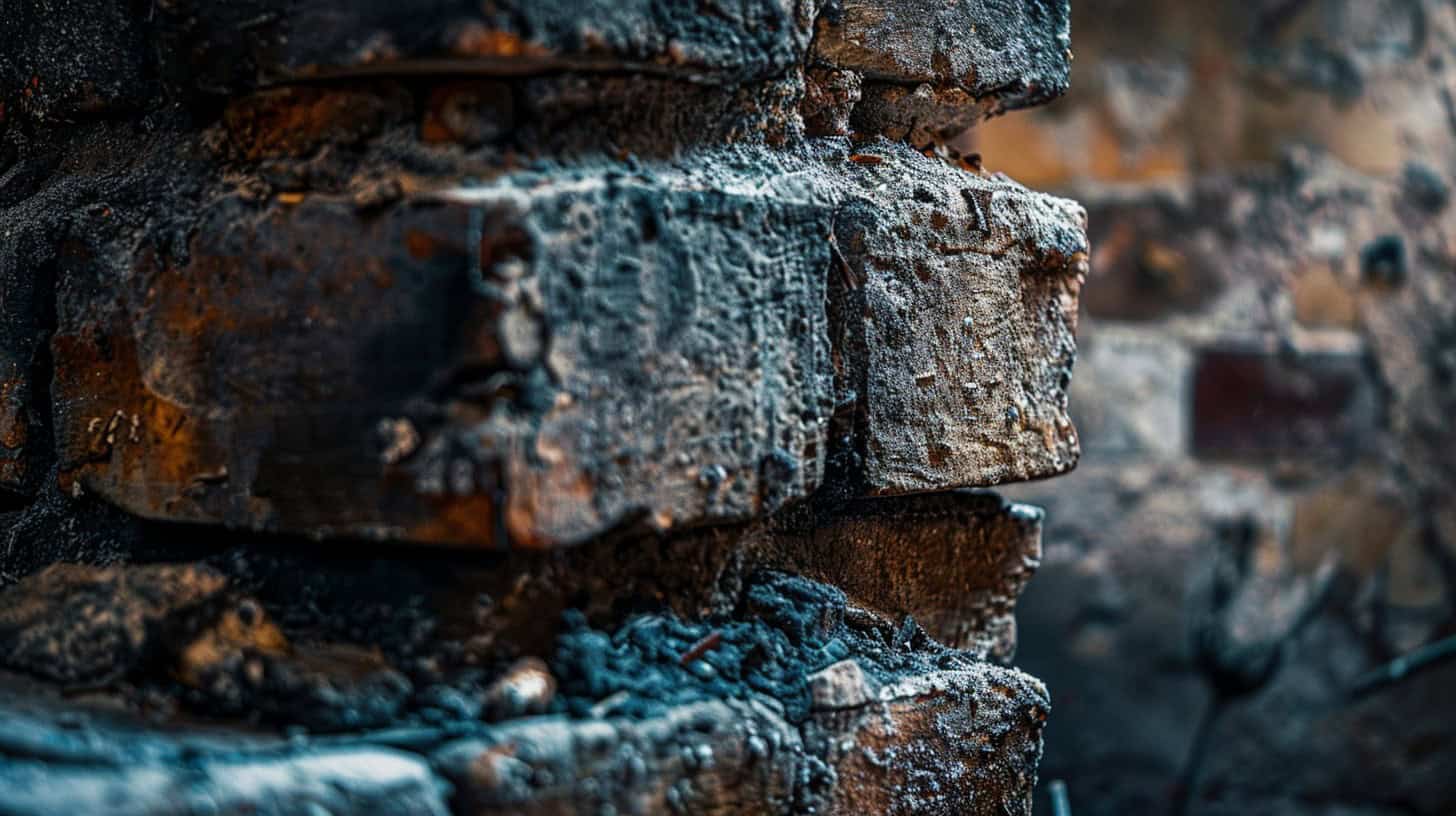Chimney brick cleaning isn’t just about aesthetics – it’s crucial for home safety. Regular maintenance prevents dangerous creosote buildup and reduces fire risks. Many homeowners overlook this task, unaware of its importance.
This guide offers expert tips and natural solutions for effective chimney brick cleaning…
From vinegar-based cleaners to tackling stubborn soot stains, you’ll learn practical techniques. 1 Get ready to transform your chimney’s appearance and boost your home’s safety…
Key Takeaways
Clean chimney bricks regularly to prevent dangerous creosote buildup and reduce fire risks – over 17,000 chimney fires occur annually in the U.S. due to neglect.
Use natural cleaners like a mix of 1/2 cup white vinegar, 2 tablespoons baking soda, and dish soap for effective and eco-friendly cleaning.
Scrub bricks thoroughly with a stiff brush, paying extra attention to crevices where soot accumulates.
Look for black oily spots, difficulty starting fires, and increased odors as signs of creosote buildup needing professional cleaning.
Schedule annual professional chimney cleanings, as recommended by the National Fire Protection Association, to ensure safety and catch issues early.
Table of Contents
Gathering Essential Supplies for Chimney Brick Cleaning
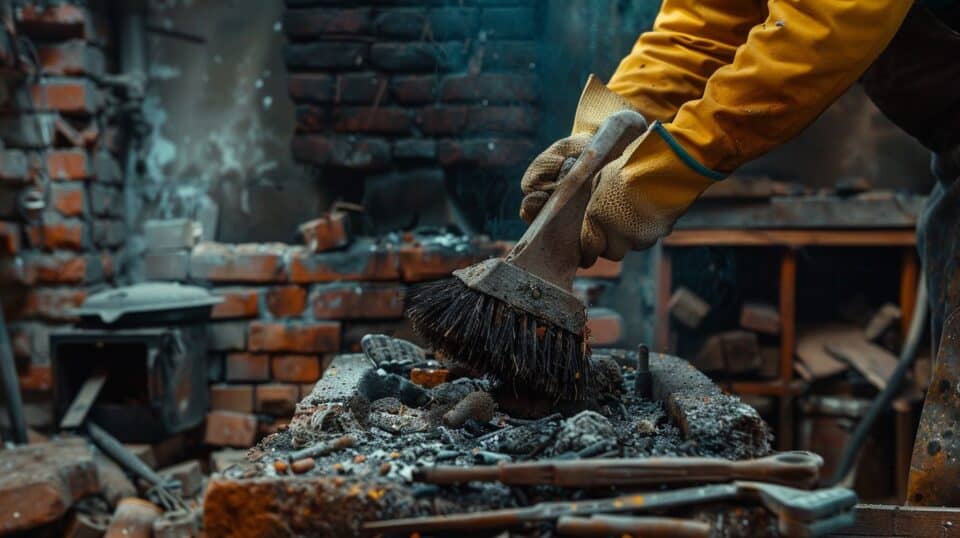
Ready to clean your chimney bricks? Let’s get you set up with the right stuff. From gloves to brushes, you’ll need a few key items to tackle this job safely and effectively. However, if you’d rather not handle this task on your own, consider hiring the best chimney sweeps Seattle to ensure everything is done properly.
Selecting effective cleaning agents: vinegar, baking soda, dish soap
Effective chimney brick cleaning starts with the right agents. Vinegar, baking soda, and dish soap form a powerful trio. Mix 1/2 cup white vinegar with 2 tablespoons baking soda and a few drops of dish soap for a potent, natural cleaner.
This solution cuts through grime without harsh chemicals. 1 For tougher stains, try a blend of 4 cups water, 1/2 cup ammonia, and 1/4 cup dish soap. 2 TSP (trisodium phosphate) offers industrial-strength cleaning—use 1/8 cup per gallon of water.
These mixtures tackle soot, creosote, and general dirt effectively.
Preparing protective gear: gloves, safety glasses
After selecting your cleaning agents, gear up for safety. Protective equipment shields you from harmful substances during chimney brick cleaning. 2
Safety goggles guard your eyes against debris and chemicals. Rubber gloves protect your skin from irritants and potential chemical burns. A dust mask filters out harmful particles.
This gear is crucial for safe fireplace maintenance. Proper protection allows you to clean effectively without risking your health. 3
Safety isn’t expensive, it’s priceless. – Author Unknown
Choosing the right cleaning tools: stiff brush, bucket
Selecting the right tools is crucial for effective chimney brick cleaning. A stiff-bristled brush, like our favorite 3″x19″ row wire brush, tackles tough soot and creosote buildup. 5 Pair it with a sturdy bucket to hold your cleaning solution and rinse water. These essentials, along with protective gear like gloves and safety glasses, form the backbone of your cleaning arsenal. 4
For stubborn stains, consider specialized tools. A shop vacuum helps remove loose debris before scrubbing. Pressure washers can be effective but require caution to avoid damaging mortar.
Natural cleaners like vinegar and baking soda often suffice, reducing the need for harsh chemicals. Always prioritize safety and effectiveness when choosing your chimney cleaning equipment.
Step-by-Step Guide to Cleaning Chimney Bricks
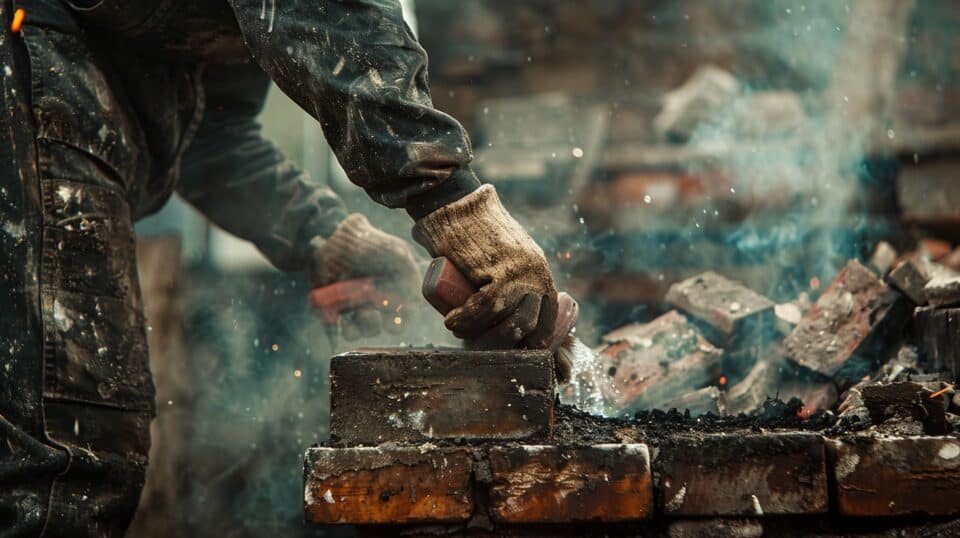
Ready to tackle those grimy chimney bricks? Our step-by-step guide makes it easy. You’ll learn the best techniques to scrub away soot and restore your fireplace’s charm.
Removing loose soot and debris
Vacuum your chimney bricks with a soft brush attachment. This gentle yet effective method removes loose soot and debris without damaging the surface. 6 For stubborn stains, use trisodium phosphate (TSP) – it’s a powerful cleaner that tackles tough grime. 7 A natural alternative? Mix equal parts vinegar and water in a spray bottle. This eco-friendly solution loosens soot effectively. 6
A clean chimney is the heart of a cozy home.
Scrub the bricks thoroughly with a stiff brush after applying your chosen cleaner. Pay special attention to crevices where soot tends to accumulate. Rinse the bricks with clean water to remove all cleaning residue.
Now, let’s explore strategies for addressing creosote build-up in chimney bricks.
Applying the right cleaning solution
After clearing loose debris, it’s time to tackle the grime. Mix a potent cleaner using vinegar and baking soda. This natural solution cuts through soot without harsh chemicals. Apply it generously with a sponge or cloth. 3 Let it sit for 15 minutes to break down stubborn stains.
For tougher spots, create a paste with cream of tartar and water. Scrub this onto problem areas with a stiff brush. Rinse thoroughly with clean water. 8 Repeat the process for extra-dirty bricks.
Most soot and smoke stains will disappear after 2–3 rounds of cleaning.
Scrubbing the bricks thoroughly
Grab a stiff bristled brush and get to work on those chimney bricks. Scrub vigorously in circular motions, applying firm pressure to loosen stubborn soot and grime. Pay extra attention to crevices and mortar lines where dirt loves to hide.
For tough stains, mix trisodium phosphate (TSP) with water and apply it to the affected areas. Let it sit for 15 minutes before scrubbing again. 6
Rinse the bricks thoroughly with clean water after scrubbing. You may need to repeat the process 2–3 times for heavily soiled areas. Always wear protective gear like gloves and safety glasses during this task.
Proper scrubbing technique is key to restoring your fireplace’s inviting appearance without damaging the masonry. 9
Rinsing bricks with clean water
Rinsing bricks with clean water is crucial for a spotless chimney. 3 Grab a non-abrasive sponge or cloth and thoroughly wash away the cleaning solution. For stubborn stains, repeat the process – patience pays off.
A bucket filled with clean water makes this task easier, ensuring every nook is properly rinsed.
A well-rinsed chimney brick is the foundation of a cozy, inviting home. 9
Proper rinsing prevents residue buildup and maintains the integrity of your fireplace. Use a gentle stream of water to avoid damaging the mortar between bricks. This final step not only removes cleaning agents but also reveals the true beauty of your restored chimney bricks, ready to enhance your living space.
Strategies for Addressing Creosote Build-up in Chimney Bricks
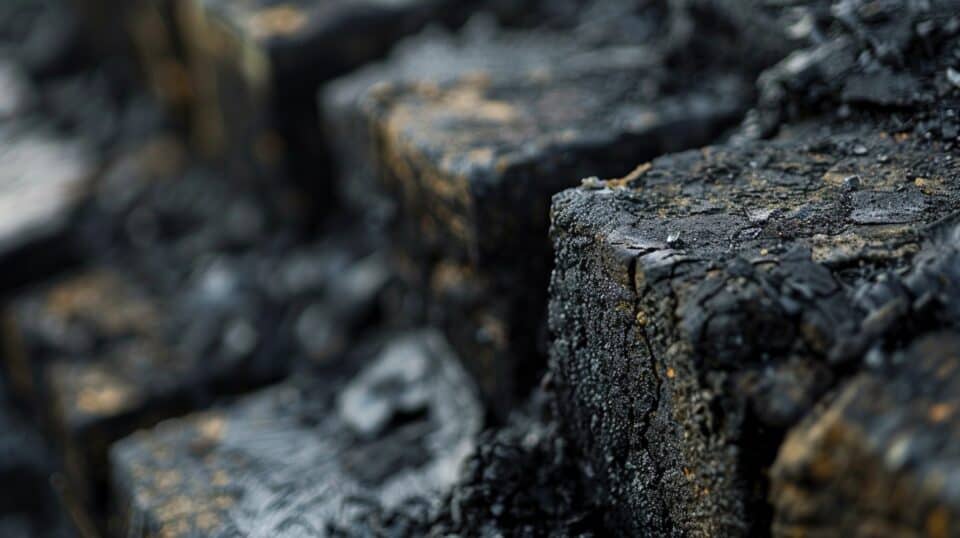
Creosote build-up in chimney bricks can be dangerous. Regular cleaning and proper tools are key to keeping your chimney safe.
Identifying signs of creosote accumulation
Black, oily spots inside your fireplace? That’s a red flag for creosote buildup. 10 Difficulty starting or maintaining fires signals trouble, too. Increased odors from your chimney or fireplace aren’t just unpleasant – they’re warning signs.
Animal or pest activity in the chimney? It could mean excessive creosote, creating a cozy home for unwanted guests. These indicators shouldn’t be ignored. Over 17,000 chimney-related fires occur annually in the U.S., often due to neglected creosote accumulation. 11 Restricted airflow, unseasoned wood, and low chimney temperatures accelerate this dangerous buildup. Next, let’s explore effective methods for removing creosote from your chimney bricks.
Choosing methods for effective creosote removal
Creosote removal demands effective methods to prevent chimney fires. High-pressure water hoses offer the best solution, blasting away stubborn buildup. 13 For severe cases, spinning wire whips or chemical solutions soften creosote, allowing easier removal with a flue brush. 12 Liquid, powder, or spray treatments break down creosote into ash, simplifying cleanup. Caution is crucial – invasive techniques can damage flues if not applied carefully. 12
Direct application of cleaning agents to fires or wood in fireplaces aids creosote breakdown. This transforms it into manageable ash, facilitating removal. Always prioritize safety and consider professional help for extensive buildup.
Regular maintenance prevents dangerous accumulation and ensures optimal fireplace performance.
Benefits of Using Natural Cleaners for Chimney Bricks
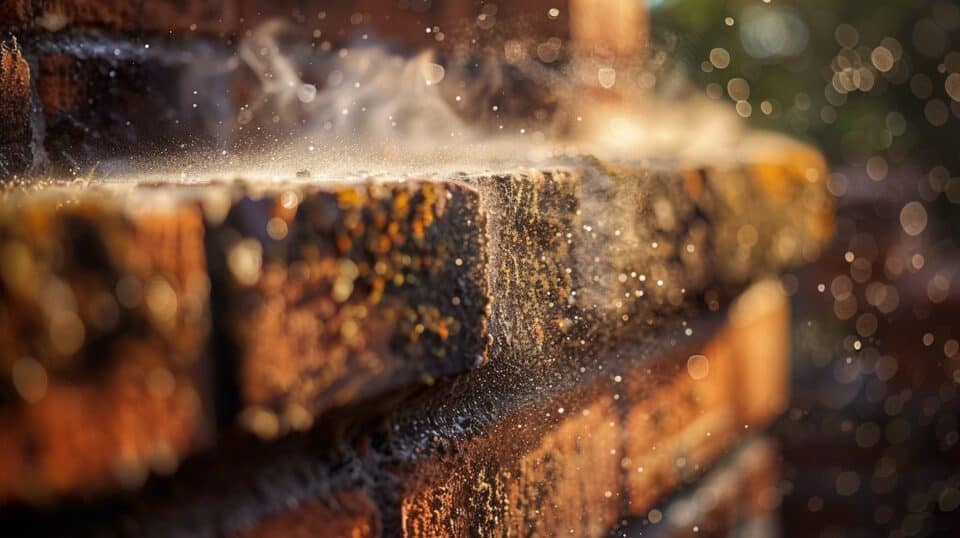
Natural cleaners are gentle on brick surfaces and safe for the environment. They’re effective at removing soot and grime without harsh chemicals.
Creating a vinegar and baking soda cleaner recipe
Mix up a powerful, eco-friendly chimney brick cleaner in your kitchen. Combine 1/2 cup white vinegar, 2 tablespoons baking soda, and 10 drops of your favorite essential oil. 14 This natural solution cuts through grime and soot without harsh chemicals.
It’s gentle on bricks but tough on dirt – perfect for regular maintenance or tackling stubborn stains.
Your homemade cleaner works wonders on chimney bricks. The vinegar’s acidity dissolves buildup, while baking soda provides gentle scrubbing power. 1 Essential oils add a fresh scent and boost cleaning properties.
This recipe is cost-effective, safe for your family, and keeps your fireplace looking pristine.
Comparing natural and chemical cleaners
Natural cleaners offer a safer, eco-friendly alternative to chemical solutions for chimney brick cleaning. Here’s a comparison:
| Natural Cleaners | Chemical Cleaners |
|---|---|
| Environmentally friendly | Can harm ecosystems |
| No harmful fumes | May release toxic vapors |
| Gentle on brick surfaces | Potentially abrasive or caustic |
| Safe for household use | Require careful handling |
| Effective for regular cleaning | Stronger for heavy buildup |
| Inexpensive ingredients | Often more costly |
Natural cleaners like vinegar and baking soda clean effectively without harsh chemicals. 1 They’re safe for you and your home. Chemical cleaners might work faster on tough stains. 15 But they pose risks to health and the environment. Choose natural options for regular maintenance. Save chemical cleaners for stubborn grime, if needed.
Tips for Preventative Maintenance of Chimney Bricks
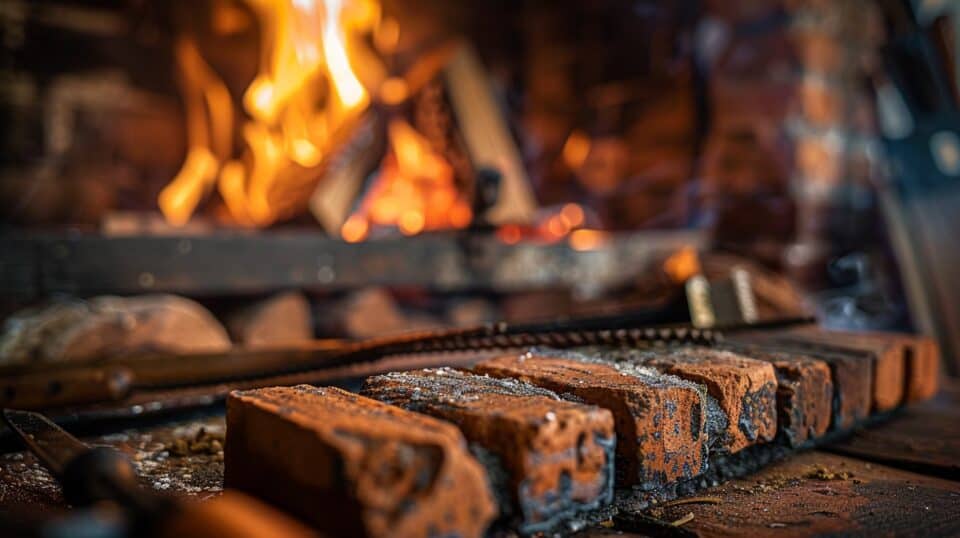
Regular upkeep is key to avoiding costly repairs. Set a cleaning schedule and know when it’s time to call the pros.
Establishing a regular cleaning schedule
Chimney maintenance demands a consistent approach. Set a yearly cleaning date – ideally before the cold season hits. Mark it on your calendar and stick to it. This simple habit prevents creosote buildup and reduces fire risks.
The National Fire Protection Association recommends annual cleanings as a minimum. 16
Your cleaning frequency may vary based on fireplace use. Heavy users should schedule bi-annual cleanings. Wood-burning fireplaces need more attention than gas ones. Keep a log of your fireplace usage to determine the best schedule for your home.
Professional chimney sweeps can offer personalized advice on cleaning intervals. Next, let’s explore when it’s time to call in the experts. 17
Knowing when to call professional cleaning services
Professional chimney sweep cleaning is crucial for safety. Excessive soot and creosote build-up signal it’s time to call experts. 17 Crumbling masonry or cracked flue liners also demand professional attention.
Regular inspections catch these issues early.
Proactive maintenance prevents hazards. Schedule annual professional cleanings to ensure a safe home. 18 Experts have the tools and knowledge to tackle complex chimney problems. They’ll remove stubborn creosote and address structural concerns effectively.
People Also Ask
Can I use pressure washing to clean my chimney brick?
Pressure washing can damage bricks. Use a scrub brush instead. For tough stains, try a mild cleaning product.
Is bleach safe for cleaning chimney bricks?
Bleach can harm bricks. Opt for gentler solutions. Vinegar and water work well for most dirt.
How do I clean rust stains off my chimney?
For rust, use a mix of lemon juice and salt. Scrub gently. Avoid harsh acids like muriatic or hydrochloric acid.
Should I clean inside the firebox?
Yes, but carefully. Vacuum ash first. Use a soft brush and mild soap. Don’t soak the bricks.
When should I consider repointing my chimney?
If mortar crumbles easily, it’s time. Repointing preserves the bricks. It’s a job best left to experts.
References
- ^ https://www.apartmenttherapy.com/how-to-clean-a-brick-fireplace-with-all-natural-cleaners-apartment-therapy-tutorials-216668
- ^ https://cleanmyspace.com/how-to-clean-brick-fireplace/
- ^ https://nwmaids.com/how-to-clean-brick-fireplace/ (2024-05-29)
- ^ https://www.prime-experts.com/blog-post/chimney-cleaning-brushes-and-supplies (2024-02-17)
- ^ https://districtofdecor.wordpress.com/2016/02/09/how-to-clean-brick-quickly-cheaply-effectively/
- ^ https://www.wikihow.com/Clean-Fireplace-Bricks
- ^ https://www.wikihow.com/Clean-Soot-from-Brick
- ^ https://www.familyhandyman.com/article/how-to-clean-fireplace-brick/
- ^ https://www.thisoldhouse.com/cleaning/reviews/how-to-clean-fireplace-brick (2024-02-24)
- ^ https://www.groundworks.com/resources/check-your-chimney-for-creosote/
- ^ https://www.prime-experts.com/blog-post/creosote-buildup-in-chimneys (2024-02-17)
- ^ https://capitolchimney.com/how-to-remove-creosote/ (2023-12-21)
- ^ https://protechchimney.com/how-to-remove-creosote/
- ^ https://keeperofthehome.org/homemade-all-natural-cleaning-recipes/ (2017-01-16)
- ^ https://www.thegoodboutique.com/inspiration/are-natural-cleaning-products-effective (2023-01-12)
- ^ https://www.naturesownchimneycleaning.com/regular-chimney-cleaning/ (2024-03-12)
- ^ https://www.betterbuilders.com/blog/chimney-maintenance-101-tips-to-prevent-a-fire-hazard-better-builders
- ^ https://www.realhomes.com/advice/fireplace-and-chimney-maintenance-in-old-homes
